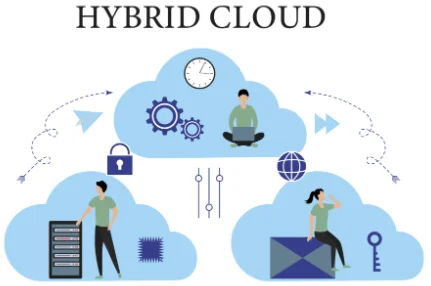Introduction:
As the organizations strive to modernize IT infrastructure, digital transformation is taken on the priority and cloud migration happens to be a critical initiative. Nevertheless, the transition from on-premise infrastructure to cloud in the enterprise environment is a road of questions and complexities, which are often bumped into with those organizations with complex and rigorous legacy systems and regulations. Hybrid cloud solutions, which are a mix of public cloud services and on-premise infrastructure, give a very good option for such organizations because they have scalability and flexibility of the public cloud services and the security and control of the on-premise infrastructure.
Understanding Hybrid Cloud:

The hybrid cloud is an IT infrastructure that combines indoors [on-premise] resources with the cloud-based services, thereby allowing the user to comfortable use data and applications across the platforms. A business can keep sensitive workloads on-premises using this method. It can also use the cloud for other workloads, benefiting from its flexibility and innovation. Key components of hybrid cloud architecture include:Key components of hybrid cloud architecture include:
1. On-Premise Infrastructure: The organization has deployed the hardware and software basis in its data centers, including servers, storage systems, and networking equipment.
2. Public Cloud Services: The top IT providers, including Amazon Web Services (AWS), Microsoft Azure, and Google Cloud Platform, are major players in the industry. They offer a variety of cloud computing services like compute, storage, and databases accessible via the internet. These companies bring a wide range of solutions to the table for businesses and individuals alike.
3. Connectivity: Robust network connectivity is vital for a cloud environment to be able to communicate with an on-premise setup. It’s important that there are no gaps in communication. This may be done through special private connections, virtual private networks (VPNs), or a mixture of both.
Building Cloud Migration Blueprint:
A successful migration to a hybrid cloud environment hinges on thorough planning and effective management. Proper execution is crucial for transitioning from traditional cloud models. Building a comprehensive migration blueprint involves the following key steps:
Assessment and Planning:
- To accomplish a comprehensive inspection of the current infrastructure, apps, and workloads, firstly spot those applications that are eligible for migration.
- Set out migration objectives, for example, cost cutting, scalability, agility, and improved performance.
- Assessed regulatory requirements and compliance, crucial for ensuring data security and control.
Workload Prioritization:
- Establish priorities according to the fit category of workloads with cloud migration, while gazing at the data sensitivity coefficient, the characteristics of data usage, and the inter-dependencies.
Architecture Design:
- Create a hybrid cloud topography, meeting the company’s needs, in terms of performance, security, and compliance.
- Assess the appropriate blend of on-premise and cloud resources for each workload, taking into account factors such as latency, data residency, and cost.
Data Migration:
- Develop a plan to migrate data from on-premise systems to the cloud while minimizing downtime. Ensure data integrity by taking necessary precautions during the migration process.
- Use cloud migration services and replication of data directly as well as synchronization alongside with them to minimize difficulties of the migration.
Application Modernization:
- The migration of legacy applications should involve modernizing them through refactoring or rearchitecting, in order to leverage cloud-native features, thereby enhancing their performance, and improving their scalability. This ensures the applications are updated and optimized for cloud environments.
- Adopt containers, microservices, and serverless computing for incorporating additional scalability, agility, and resilience.
Security and Compliance:
- Use strong security controls and compliance measures in a hybrid cloud environment to address sensitive data and, moreover, applications that require extra protection.
- You can use identity and access management (IAM), encryption and network security solutions to not only keep away the threats and vulnerabilities, but also protect your systems and data from unauthorized access and breaches.
Operations and Management:
- Cloud services nowadays dominate the processing and storing of vast amounts of data in modern work. You must create the hybrid cloud management model with a focus on various operational processes and procedures. This is necessary to properly maintain the network of these environments.
- To enhance performance and manage resources effectively, create monitoring, logging, and automation tools. These utilities will help govern performance, maximize availability, and streamline resource management.
Read Also: What Are The Best Practices For Protecting Data In Edge Computing Environment
Conclusion:
While moving to a hybrid cloud gives firms the option to join on-premises infrastructure and cloud services, organizations can take the utmost benefits from this. A structured migration blueprint outlines the steps to be taken in dealing with the complexities.The blueprint emphasizes the assessment, workload prioritization, architecture design, data migration, application modernization, along with security and compliance. The blueprint also covers operations management. Taking these, it is of great importance in the full-fledged hybrid cloud deployment.
From my perspective, the hybrid cloud approach offers a practical solution for diverse IT requirements. It combines the benefits of cloud convenience, boldness, and innovation while also addressing data security and compliance concerns effectively. This approach balances the advantages of cloud services with the need for secure and compliant data storage. The hybrid cloud architecture enables businesses to be agile and efficient in response to market changes. It also fosters innovation within their digital ecosystem by encouraging collaboration and creativity. Organizations are embracing hybrid cloud. The path to hybrid cloud is a never-ending journey that requires constant assessment, improvement, and natural evolution. This is necessary to accommodate changing business necessities and technological progression.

